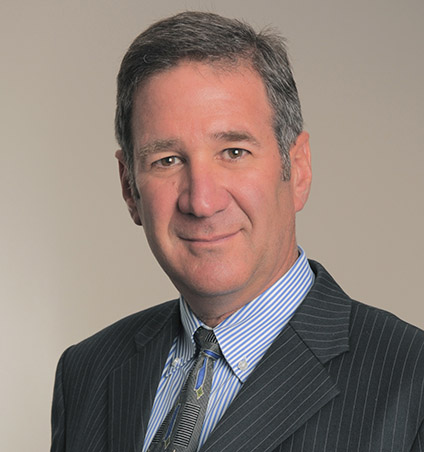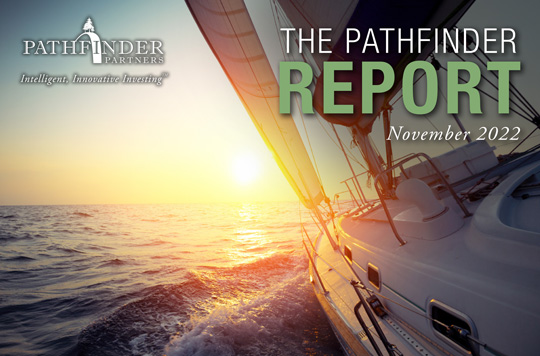Charting the Course
Five Lessons in Resilience from The Old Man and the Sea
By Mitch Siegler, Senior Managing Director

The story of Santiago, the fisherman in Hemingway’s The Old Man and the Sea, is one of resilience – toughness or the ability to recover quickly from difficulties. Santiago has unparalleled knowledge of the sea and his craft, which prepares him for an unimaginable string of hardship and misfortune. He has been unable to catch fish for 84 days and is dragged further out to sea where he sees storm clouds brewing. The marlin with which he struggles for three days is a remarkable test of his strength and endurance. Santiago catches the fish and straps it to his skiff though it’s later eaten by sharks.
 The book teaches many lessons, including perseverance, the importance of being prepared and how character helps us endure hardships and overcome obstacles. Investors also face challenges, though not of the sort faced by the Old Man. Yet preparation and character are no less important to investors than they were to Santiago. And taking steps to increase resilience are key to success in both the open ocean and the markets.
The book teaches many lessons, including perseverance, the importance of being prepared and how character helps us endure hardships and overcome obstacles. Investors also face challenges, though not of the sort faced by the Old Man. Yet preparation and character are no less important to investors than they were to Santiago. And taking steps to increase resilience are key to success in both the open ocean and the markets.
An economic storm is brewing. We all see the headlines and are disturbed by rising interest rates, 40-year-high inflation, and escalating layoffs. We feel the pinch of inflation when we visit the grocery store and the gas station and worry about the other shoe dropping.
We face strong economic headwinds today: High inflation, slowing growth and a possible recession – all playing a role in the substantial declines in the value of our IRA and 401(k) retirement accounts this past year. In the face of storms, we batten down the hatches, protect sensitive and vulnerable equipment, tread carefully and hold on tight.
While it’s possible to take steps to prepare just before the storm arrives, it’s far preferable to make sure your boat is seaworthy, and your home’s roof is water-tight long before the rains and heavy winds arrive. Storms are inevitable and bad things do happen. Some make it through unphased while others are decimated. Those who are exceptionally well prepared and well insured are more resilient.
Five Ways an Investor Can Build Resilience
There are numerous tools for increasing one’s resilience. Among them are reading the landscape, stacking the deck in your favor, creating adequate cash reserves, taking a ‘belt and suspenders’ approach and contingency planning.
-
Reading the Landscape – The Old Man knew enough to monitor the weather and maintain his boat before heading out to sea. Great investors have humility and usually don’t try to build a strategy around market timing, but they carefully consider portfolio construction and diversification and are not afraid to weight their portfolio with assets that are lined up well for upcoming market conditions. For example, technology stocks generally outperform in bull markets and investors can find shelter in consumer non-durables during downturns. Many investors enjoy success by rotating out of one and into another as market cycles change. We’ve long espoused our belief that multifamily (apartment) investing, because of a major housing shortage, is a strategy for all seasons and is a particularly resilient asset class when the economy experiences a downdraft. That doesn’t mean we don’t step on the accelerator at some points in the cycle and tap the brake pedal at other times. Multifamily is also an excellent inflation hedge because of the shorter duration lease terms (typically a year or less). And, multifamily lends itself to attractive, long-term financing. Those are among the reasons investing in multifamily is all we do. Having greater focus makes you a stronger investor and making sure your investment strategy is properly aligned with the times and those that might be coming sets you up for success. A well-constructed and properly diversified portfolio, discussed further below, is also a powerful tool.
-
Stack the Deck in Your Favor – Astute investors often follow the old saw, invest in what you know. Some friends have made a killing in the options market, but we’re not experts and have long avoided that sort of trading. At Pathfinder, we’ve done deep research and have years of experience in six western U.S. markets which are rapidly growing and severely housing constrained. We could venture elsewhere but we believe building on our existing base of knowledge and experience provides us with a margin of safety. When you have deep knowledge and experience about a few things, we believe you have an advantage, and the deck is stacked in your favor.
Diversification can be another strategy for stacking the deck in your favor. Several friends whose comfortable retirements are assured bought Apple stock early on and never missed a beat when that position grew to 80% of their portfolio value – but that level of portfolio concentration is not for us! We believe in diversification and have long held that a diversified fund with several properties in various cities balances out short-term issues at one property or swings in a particular city. And because multifamily investment performance is not historically highly correlated with returns from traditional investments (equities and fixed income), we believe that apartments deserve a place in an investor’s diversified portfolio.
-
Cash is King – Santiago had bait aboard as well as the tools and experience to create more bait, as required. That provided him with flexibility and allowed for extra time at sea. Investors in emerging companies often call a company’s cash balance its “runway” and consider its length before investing. For both businesses and individual investors, cash liquidity is key during periods of volatility. Companies can build their liquidity by increasing the levels of cash/marketable securities on their balance sheets and putting lines of credit in place that they could tap if they’re impacted by economic headwinds.
 Similarly, individual investors may need staying power to ride out the storm. They can achieve this with a cash cushion, a personal line of credit or a home equity credit line (effective tools irrespective of whether they’re utilized), as examples. While many don’t like holding cash in inflationary times, today one can earn 2-3% in Certificates of Deposit or Money Market accounts and a whopping 6.89% on government six-month Series I Bonds, though each person is capped at $15,000 on these.
Similarly, individual investors may need staying power to ride out the storm. They can achieve this with a cash cushion, a personal line of credit or a home equity credit line (effective tools irrespective of whether they’re utilized), as examples. While many don’t like holding cash in inflationary times, today one can earn 2-3% in Certificates of Deposit or Money Market accounts and a whopping 6.89% on government six-month Series I Bonds, though each person is capped at $15,000 on these.Many companies with the foresight to raise more capital than they thought necessary several years ago weathered the pandemic and the famine in the capital markets that came in its wake. Those without that foresight suffered and today, only the better private companies can raise capital (other than on extremely onerous terms). It can make a huge difference to a company’s survival chances in a famine (when orders are scarce, or supply chain issues upset production schedules) if their cash runway is 12 or 36 months. That can be the difference between death and survival.
Similarly, individual investors can use their cash liquidity or credit lines as a rainy-day fund and to take advantage of investment opportunities – which often present themselves during stormy periods. Those who use techniques like dollar cost averaging (buying additional stock when the share price plummets to reduce the average cost per share) need strong stomachs to buy more in the face of a declining share price – and that’s where liquidity can help. At Pathfinder, we consider cash reserves when we eat, breathe and sleep. We want our properties and funds to have sufficient cash reserves. What if occupancy declines or rent growth slows? What if there’s a need for an unplanned, major capital expenditure? We address these concerns with healthy cash reserves.
-
Belt and Suspenders Approach – Many used the low interest rate environment during the pandemic to refinance their home mortgages. They’re sitting pretty with their 3% mortgages as compared with current rates above 7%. Until recently, it was cheaper to borrow with variable-rate loans than to use fixed-rate financing. Owing to our desire to sleep well at night, we generally use fixed-rate financing for our stabilized properties. Those loans are more expensive, but they serve as an insurance policy protecting us from rising interest rates. Today, our Pathfinder Income Fund has a dozen properties with seven- to ten-year, fixed rate loans with a weighted average borrowing cost of 3.2%. That’s an extraordinary asset in a period of high inflation or when the economy looks poised for a downturn – we may be looking at both.
Speaking of insurance, it’s heartbreaking to hear stories of people who lost everything in a hurricane and to learn that their flood insurance lapsed, or they had inadequate property insurance coverage. Some of our Pathfinder properties reside in earthquake zones. Lenders typically require borrowers to maintain adequate property insurance, but earthquake riders are generally not required. Nonetheless, we generally buy them anyway as our investors will be mildly annoyed about an additional $10,000-$20,000 annual insurance expense but would be extremely perturbed if an earthquake destroyed a property. Fixed rate and longer-term loans, like plenty of insurance are hedges. They come at a cost but depending on your attitude about risk may be worthwhile. Wearing both a belt and suspenders won’t win any fashion awards but you’re unlikely to be caught with your pants down!
-
Contingency Planning – Scenario planning and sensitivity analysis are terrific – we have plenty of experience with these types of approaches. They help you envision scenarios in the future and consider ways to prepare for them. But all the “What if?” analysis in the world won’t help you when the day of reckoning arrives. We’d rather absorb higher insurance premiums to gain a better night’s sleep. We also don’t like the feeling in the pits of our stomach when the loan statements arrive showing higher interest rates and monthly payment amounts. And perish the thought of telling our investors about our need for an unplanned capital call or that the regularly scheduled quarterly distribution will be reduced or delayed. Contingency planning helps one set the stage for playing it safe.
In volatile, turbulent periods, it’s harder to look around the bend to see what might be coming. How many more rounds of interest rate hikes are ahead? Is the bear market in stocks ending or just getting started?
At Pathfinder, we wonder about the level of apartment rent growth next year. It’s highly unlikely to be anywhere near as strong as it was last year. Will occupancies, at historically high levels, hold? Who knows? With storm clouds on the horizon, we’re prioritizing occupancy and working even harder to hold onto our tenants, even if it means we sacrifice a bit on rent levels.
It’s stormy out there and we’re grateful for our blessings – including resilience. We wish you and yours a very Happy Thanksgiving.
Mitch Siegler is Senior Managing Director of Pathfinder Partners. Prior to co-founding Pathfinder in 2006, Mitch founded and served as CEO of several companies and was a partner with an investment banking and venture capital firm. He can be reached at msiegler@pathfinderfunds.com.
Share this Article
IN THIS ISSUE
PATHFINDER PARTNERS INCOME FUND, L.P.
A Stablized Multifamily Fund
CHARTING THE COURSE
Five Lessons in Resilience from The Old Man and the Sea
FINDING YOUR PATH
A Few Musings from the Front Lines
GUEST FEATURE
Great Communication is Crucial in Baseball and in Investing
ZEITGEIST
News Highlights
TRAILBLAZING
Creekside Apartments, Vista (San Diego), CA
NOTABLES AND QUOTABLES
Resilience
